Abstract
Brazil is considered one of the world’s most important sisal fiber producers (derived from Agave sisalana), with areas concentrated in the Bahia state. There has been a movement in agriculture toward a circular economic system (take-produce-consume-recycle). Based on this idea, the focus of this study was: (i) to estimate the theoretical available amount of sisal residues based on fiber and area productions; (ii) to monitor the use of sisal residues for improving sisal plant growth; and (iii) to monitor the residue stocks on surface soil with the application of sisal residues. Areas of sisal were visited periodically, monitoring the application of sisal residue on the soil surface. The results showed that there is an expressive production of sisal residues, mainly of green liquid, sisal pulp, and sisal ball. The application of sisal pulp on the soil surface, close to sisal plants, is an optimal alternative to improve sisal leaf development. The application of sisal residues on soil increased 50% of residue stocks with sizes lower than 10 cm. Based on the results, we concluded that the sisal residues have a great potential for improving sisal plant growth and soil residue stocks. More studies are required to improve circular agriculture in the sisal sector.
1. Introduction
The circular economy is presented as a strategy with the dual purpose of improving economic performance and minimizing the impact of waste generation [1]. In Brazilian agriculture, there is a movement and conversion from a linear economic system (take-produce-consume-discard) to a circular economic system (take-produce-consume-recycle). This process can help to guarantee the sustainability of agriculture, promoting and generating solutions in the field and industry [2].
Agriculture has great potential within a circular economy, with the transition to sustainable, restorative, and regenerative agriculture and systems of production focusing on economic, environmental, and social sustainability [3]. In tropical agriculture, the main residue crops studied are derived from grasses or legumes, including sugarcane (Saccharum officinarum), soybean (Glycine max), and Brachiaria (Brachiaria decumbens), which present different chemical compositions and concentrations of free sugars, lignin, starch, pectin, hemicellulose, and cellulose [4,5,6,7,8].
Brazil is considered one of the world’s most important sisal fiber producers (derived from Agave sisalana), with areas concentrated mainly in the Bahia state. In the 2023/2024 crop season, Bahia produced 782 million tons of sisal fiber over 10 million hectares, representing 95% of Brazil’s area [9]. The Baiana areas of sisal are located in the Northeast and the North Center, which present higher production areas and productivity [10]. This region is situated in the semiarid and arid regions, namely Caatinga, and is characterized by a large geographical area comprising different vegetation types under a dry tropical climate. The annual rainfall ranges from 500 to 800 mm, with temperatures between 23 °C and 27 °C and evaporation of 2000 mm/year. The rainfall regime is marked by scarcity and irregularity, with a concentration of precipitation in a short period (from 3 to 4 months) [11]. Based on climate conditions, agriculture in arid regions faces significant challenges with water scarcity and low crop yields.
Given climate change and the increase in arid and semiarid regions, studies are required to promote species that have the potential to produce food, fiber, and energy. Sisal is presented as a strategy for arid and semiarid regions, requiring alternatives to increase yield and sustainability. Sisal can be harvested 36 months after planting, with a production of between 50 and 60 leaves. After harvesting, the leaves are defibrated, removing the pulp that surrounds the leaf fiber. The products derived from sisal are ropes, rugs, carpets, bags, purses, hats, and brooms, as well as various handicrafts [12].
In the process of defibration, there is a large production of residues characterized as liquid (green juice) and solid (pulp/mucilage and broken fiber). In Brazil, the mucilage has been used for animal feed and sisal fertilization itself [13,14]. Focusing on soil application, after the defibration, the producers take the residues (green juice + mucilage + broken fiber) and apply them on the soil surface, close to the sisal plant, forming a residue layer higher than 30 cm. There are no studies demonstrating the efficiency and impact (positive or negative) of this management used by the farmers on sisal production.
Crop residues on soil promote significant ecological, economic, environmental, and social benefits in the agricultural systems [15,16,17]. The residues added to the soil surface can be derived from agro-industrial and agricultural activities with the production of plants and/or animals locally or from other sites. Crop residues can increase the organic matter, soil-beneficial organisms, and nutrients for plant growth [18,19]. In addition, crop residues can protect the soil from great variations in temperature, light, and water, and may also protect the soil from erosion caused by wind or heavy rainfall events [16,17,18,19,20]. The crop residues are also a source of carbon in the systems with carbon sequestration in the soil, which directly mitigates the concentration of greenhouse gases in the atmosphere, mainly carbon dioxide [21,22].
Based on this idea, the focus of this study was: (i) to estimate the theoretical available amount of sisal residues based on fiber and area productions; (ii) to monitor the use of sisal residues for improving sisal plant growth; and (iii) to monitor the residue stocks on surface soil with the application of sisal residues.
2. Materials and Methods
2.1. Site Characterization
The study was carried out in the areas of sisal in the region of Conceição do Coité, Bahia, Brazil (11°33′50” S 39°16′58″ W). The region is located in the Sisal territory region, Northeast Mesoregion, 210 km from the capital (Salvador), Bahia (Figure 1). The sisal territory is characterized by its proximity to the Feira de Santana region and the Port of Salvador, with agriculture focused on small producers of sisal.
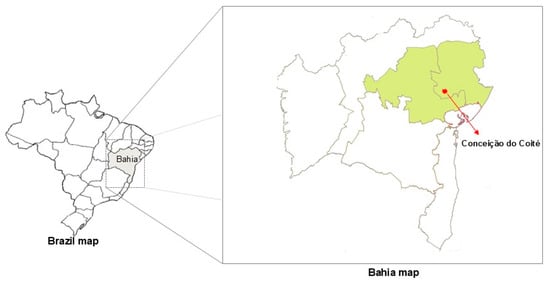
Figure 1.
Sites in the region of Conceição do Coité, Bahia, Brazil.
The city of Conceição do Coité presents a population of 67,013 inhabitants and a total area of 1086.224 km2 with a small urban area (18.57 km2), characterized as a rural city [23]. The Conceição do Coité region is known as the “Sisal Capital”, responsible for processing a large part of the sisal production in Brazil. The main economic activity in the region is the cultivation of sisal for processing fiber and manufacturing sisal blankets, threads, and ropes. The region also has a significant herd of cattle, horses, goats, sheep, and poultry.
The climate of the region is classified as BSh, according to the Köppen-Geiger climate classification, characterized as dry with poor, rare, and concentrated rainfall between the periods of November and April. The average annual rainfall is around 585 mm, with high evaporation rates and an altitude of 420 m.
2.2. Experimental Desgin
Areas of sisal with plants of 10–12 years were visited periodically during 2024 and 2025 in the region of study (totaling 10 visits during the study). We separated the areas into (i) areas with the application of sisal residues on the soil surface (areas 1 and 2) and (ii) areas without the application of sisal residues on the soil surface (areas 3 and 4). We selected four sites with sisal stands of 8–10 years, surrounding the same soil and climate types (Figure 2).

Figure 2.
Experimental design with sisal residues in the region of Conceição do Coité, Bahia, Brazil.
Both managements are commonly used in the region. When the sisal residue is applied on the surface soil, there is the formation of a residue layer, close to the plant, with a size between 30 and 50 cm. There is no application of residues on the line of planting; the plant is just closed. There is no information on the quality of residues and the availability of nutrients, carbon, and humidity.
2.3. Residue and Plant Development
During the monitoring, plants, and residues on the soil surface were collected to monitor the plant development and residue accumulation on the soil.
In each area, plants were randomly selected with a size between 1.5 and 1.7 m and an age between 5 and 8 years. A total of 20 plants were selected in each experimental area. Plants with symptoms of disease or nutritional deficiency were not sampled in the field. In each selected plant, we collected four leaves in the middle of the plant, totaling 80 leaves for each area and 320 leaves for four areas. The leaves were placed in the bags and transferred to the laboratory.
In the laboratory, the leaves were weighed to obtain the fresh leaf mass. We also monitored (i) the length of the leaf (from the base to the terminal spine), (ii) the length of the terminal spine, (iii) the thickness of sisal leaves on the base of leaves; and (iv) the thickness of sisal leaves on the middle of leaves.
The volume of residues accumulated on the surface soil was monitored on the line of planting using a wooden frame of 0.25 m2 (50 cm × 50 cm), which was randomly placed in each study area. The residues in the wooden frame were collected, placed in the bags, and separated into (i) residues lower than 10 cm in diameter and (ii) residues higher than 10 cm in diameter. The residues collected were dried, and it was not necessary to dry them in the oven. The data of residue accumulation were converted to ton/ha (Figure 3).
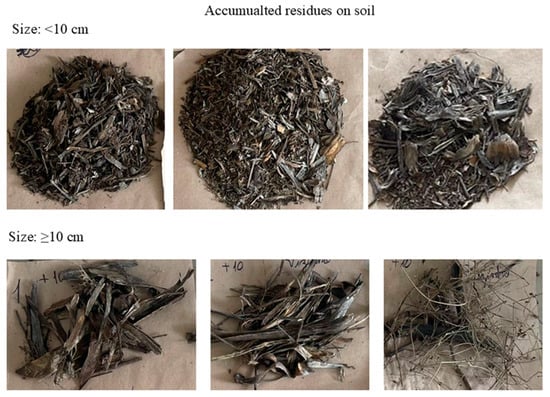
Figure 3.
Residues accumulated on the surface soil and separated into (i) residues lower than 10 cm in diameter and (ii) residues higher than 10 cm in diameter in the region of Conceição do Coité, Bahia.
2.4. Data Analysis
The database was analyzed using descriptive analysis to assess the quality of the data with measurements of centralization and dispersion. Data quality was also analyzed according to the tests of normality (Shapiro–Wilk test; p < 0.05), homogeneity of variance (Bartlett test; p < 0.05), and the coefficient of variation indicator (CV, %).
The data on plant development and residue accumulation on soil were tested using the analysis of variance (ANOVA). When there was a significant difference between the means, the means were compared using the LSD test (p < 0.05). The correlations between leaf mass, length of leaf, the terminal spine, and the thickness in the base and middle leaf were tested according to Pearson’s test (p < 0.05).
The theoretical available amount of sisal residues was estimated based on fiber and area productions. The data were obtained in the Sidra platform in the IBGE dataset [9]. The primary data can be found in Table S1 Supplementary.
We calculated the production of sisal residues derived from the leaves (described here as solid material, sisal pulp; and liquid material, green liquid) and the trunk (known as the sisal ball). We used a ratio that for each 1 ton of processed fibers, it produced about 24 tons of leaf residues (sisal pulp; mucilage, and loofah) and 100 m3 of wastewater (green liquid). For each 1 hectare of sisal plantation, it produces 7 tons of sisal balls (old plants), which were removed per year.
This calculation was based on the population of 3500 plants per hectare and a weight of 20 kg per sisal ball (10% of sisal balls produced annually). These calculations were based on studies of Terrapon-Pfaff [12], TSB [24], and GTZ [25].
All analyses were performed using the R language (version 4.5.1), and the data were graphed in Sigmaplot (version 14).
3. Results
3.1. Residue Accumulation on Soil
The volume of accumulated residues on the soil surface ranged from 8.5 to 18.3 tons/ha. Areas without the sisal residues presented lower accumulation with an average of 8.5 tons/ha (Area 1) and 10.5 tons/ha (Area 2), as shown in Figure 4.
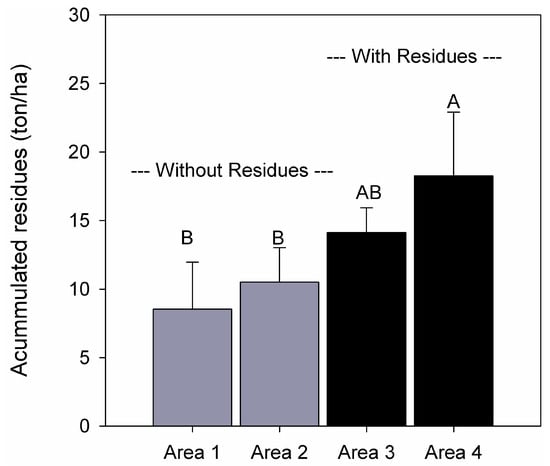
Figure 4.
Accumulated residues on surface soil in sisal areas with the application of sisal residues (Areas 3 and 4) and no residue application (Areas 1 and 2) in the region of Conceição do Coité, Bahia. Bars with different letters are significantly different according to the LSD test (p < 0.05).
There was an increase of 50% in residues on the soil surface with the application of residues, with an average of 14.1 tons/ha (Area 3) and 18.3 tons/ha (Area 4), as shown in Figure 4. Also, there was a predominance of residues with sizes lower than 10 cm in both managements, with an average of 6.2 tons/ha (Areas 1–2) and 12.4 tons/ha (Areas 3–4), as shown in Figure 5.
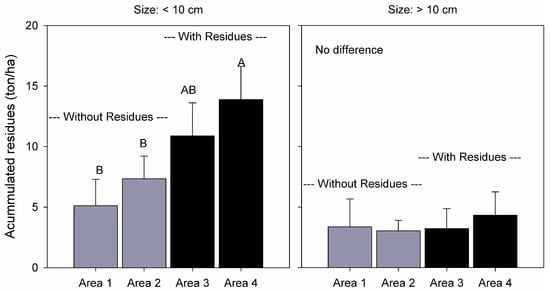
Figure 5.
Sizes of accumulated residues on surface soil in sisal areas with the applications of sisal (Areas 3 and 4) and no residue application (Areas 1 and 2) in the region of Conceição do Coité, Bahia. Bars with different letters are significantly different according to the LSD test (p < 0.05).
The applications of sisal residues on the soil surface promoted an accumulation of 50% of residues with a size lower than 10 cm (Figure 4). Interestingly, there was no clear difference between the managements with residues at sizes higher than 10 cm, with the accumulation ranging from 3.0 to 4.3 tons/ha (p> 0.05), as shown in Figure 5.
3.2. Plant Development
The leaf length of sisals was greater in areas where sisal residues were applied, with averages ranging from 1.0 to 1.1 m (Areas 3 and 4), representing an increment of 10% compared with the area without sisal residue application (Areas 1 and 2), as shown in Figure 6.
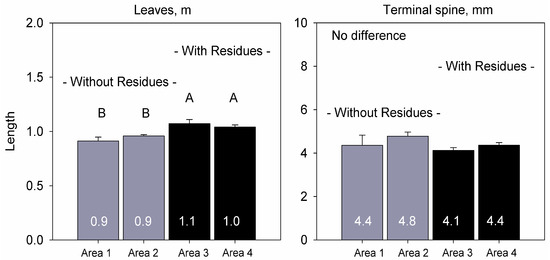
Figure 6.
Length of leaves and terminal spine in sisal plants in areas with the application of sisal residues on the soil surface (Areas 3 and 4) and no residue application (Areas 1 and 2) in the region of Conceição do Coité, Bahia. Bars with different letters are significantly different according to the LSD test (p < 0.05).
The length of the terminal spine was not altered by the management of sisal residues, with averages ranging from 4.1 to 4.8 mm (Figure 6). The thickness was monitored on the base and middle of the leaves, and there was also no clear difference in thickness in the leaf base (Figure 6).
In the areas with residue applications, there was a reduction in the thickness in the middle of leaves with averages of 4.4 and 4.3 mm (Areas 3–4). While the leaves without residues presented a thickness ranging from 5.4 to 5.5 mm (Figure 7).
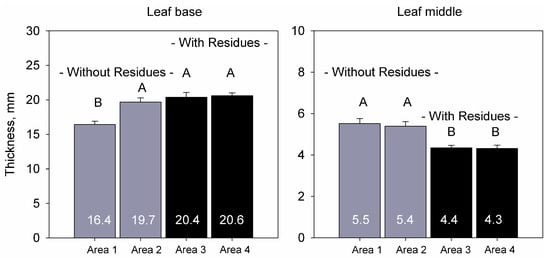
Figure 7.
Thickness of sisal leaves at the base and middle in areas with the application of sisal residues on the soil surface (Areas 3 and 4) and no residue application (Areas 1 and 2) in the region of Conceição do Coité, Bahia. Bars with different letters are significantly different according to the LSD test (p < 0.05).
Fresh leaf mass was higher in areas with the application of sisal residues on the soil surface, with averages ranging from 410.0 to 423.9 g (Areas 3–4). Area 4 presented the highest leaf production, with production 39.7% higher than Area 1 and 15.7% higher than Area 2 (Figure 8).

Figure 8.
Leaf mass in sisal areas with the application of sisal residues on the soil surface (Areas 3 and 4) and no residue application (Areas 1 and 2) in the region of Conceição do Coité, Bahia. Bars with different letters are significantly different according to the LSD test (p < 0.05).
3.3. Correlations
Leaf mass was correlated with all leaf factors with p-values of 0.62 (leaf length), 0.71 (base leaf thickness), and −0.22 (middle leaf thickness), as shown in Table 1. Positive correlations indicated that increased leaf mass was associated with an increase in leaf length and thickness at the base of leaves, as expected in the study.

Table 1.
Correlation between leaf mass, leaf length, terminal spine length, base thickness, and middle leaf thickness in areas with/without the application of sisal residues on the soil surface in the region of Conceição do Coité, Bahia.
The increase in the thickness of the middle of the leaf negatively influenced all the variables of the leaves, with negative correlation values of −0.10 (leaf length), −0.22 (leaf mass), and −0.25 (thickness of the leaf base), as shown in Table 1.
3.4. Volume of Sisal Residues
In Brazil, the annual volumes of sisal residues were 4,053,951 ton per year−1 of sisal pulp, 16,891,462 m3 per year−1 of green liquid, and 1,347,874 ton per year−1 of sisal ball. If we consider the last 20 years, there was a total production of 97,294,824 tons of sisal pulp, 405,395,100 m3 of green liquid, and 32,348,981 tons of sisal ball (Table 2; Figure 9).

Table 2.
Brazilian production of sisal residues (sisal pulp, green liquid, and sisal ball) in the last years (from 2000 to 2023) in the region of Conceição do Coité, Bahia.
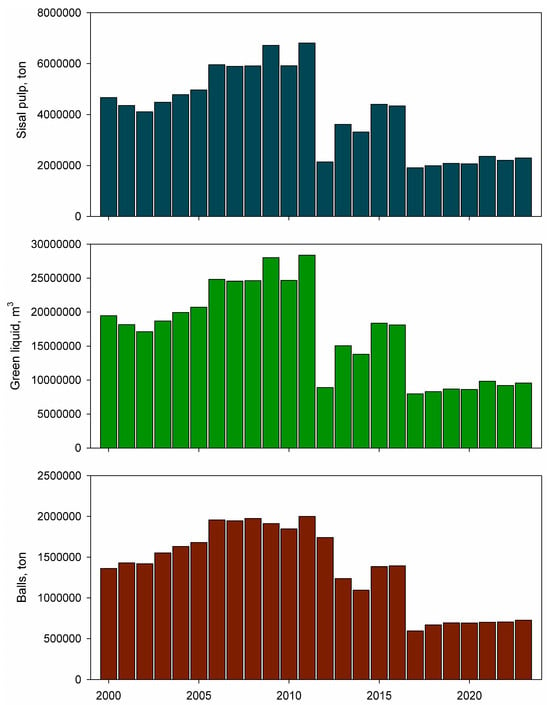
Figure 9.
Brazilian production of sisal residues (sisal pulp, green liquid, and ball) in the last years (from 2000 to 2023) in the region of Conceição do Coité, Bahia. Data are based on IBGE [9], Terrapon-Pfaff [12], TSB [24], and GTZ [25].
In the last few decades, there has been a reduction in the production of sisal residues, represented by a percentage of 50%. The residue productions are associated with the areas and productions of fiber in the sisal sector. Therefore, as there were reductions in the production of sisal areas and the production of fiber, the results had a direct impact on the production of pulp, green liquid, and balls from 2000 to 2023 (Figure 9).
4. Discussion
In Brazil, there is an expressive annual production of sisal residues, mainly of green liquid (16,891,462 m3 year−1), sisal pulp (4,053,951 ton year−1), and sisal ball (1,347,874 ton year−1). These results were expected due to sisal leaves only containing 3–5% hard fiber, and the remaining 95–97% are classified as residues in the sisal sector [26]. On a large scale, there has been no use of these residues with a direct impact on industry and the local community. Here, we tested the application of sisal pulp on the soil surface, close to sisal plants, in the areas of local and small farmers.
The application of sisal pulp increased the leaf length (ranging from 1.0 to 1.1 m) and leaf mass of sisal (ranging from 410.0 to 423.9 g). Naik et al. [27] monitored the physical properties of sisal leaves, finding leaf lengths ranging from 0.54 to 1.62 m with an average of 1.0 m. The leaves are associated with vascular fibers, characterized as vegetative structures that are commercially desirable [28,29]. Therefore, the application of sisal pulp on the soil surface, close to sisal plants, is an optimal alternative to improve leaf development. This result is corroborated by Jin et al. [26], Wen et al. [30] and Liu et al. [31], and, who showed that returning sisal residue to the field can increase sisal yields.
The application of sisal pulp also promoted the thickness of the base of leaves. The leaves of Agave sisalana are characterized as fleshy, with strongly cutinized epidermal cells. The epidermis, in frontal view, shows polygonal, generally hexagonal, and elongated cells. The anticlinal walls are straight and strongly thickened [32]. In the Brazilian semiarid, there was a high variation in the thickness of leaves due to the drought season, with low water available to the plants. In this season, the sisal leaves lose water, becoming wilted and reducing the thickness of the leaves. Therefore, the thickness of leaves is related to the water accumulation and hexagonal and elongated cells, which are affected by residue addiction without control. Probably, the sisal pulp, which also presents a high level of water, could promote a higher soil water retention in the region close to the plant. The sisal pulp also presents a high content of alkaloid derivatives, coumarins, tannins, and saponins as the main components [33]. This class of metabolites has therapeutic functions and protects plants and animals from insects and diseases [28,29].
The length of the terminal spine was not altered by the management of sisal residues. The terminal spine presents a red-brown color, characterized as hard and with rigid extensions. Plant spines are a manifestation of their long-term evolutionary adaptation to adverse environmental and survival conditions [34]. We expected to find a significant difference in the management of residues impacting the length of the terminal spine, which could be linked to the higher soil water retention in the region close to the plant.
Some studies have indicated the use of mucilage (which is characterized as the part of sisal pulp without small fiber) for animal feed in the form of silage and hay due to high nutritional quality [35]. Sisal residues are rich in nutrients such as carbon, nitrogen, phosphorus, and potassium [26]. Therefore, it can also be a great alternative as a source of nutrients for animals as well as for plants. Gebremariam and Machin [14] showed that sisal pulp (Agave sisalana Perrine) used to feed sheep in Eritrea presented values ranging from 14.8 to 18.8% for ash, 6.8 to 7.7% for crude protein, 1.1 to 1.3% for fat, 14.2 to 16.3% for crude fiber, 11.2 to 12.1% for gross energy, and 56.3 to 62.9% for nitrogen-free extract. Sisal residue tested by Jin et al. [26] presented an organic matter content of 21.30%, a total nitrogen content of 0.42%, a P2O5 content of 0.14%, a K2O content of 0.52%, and a carbon-nitrogen ratio of 50:1. These results demonstrated that the nutritive value of sisal pulp is much better than that of barley straw, for example. In Tanzania, Kavishe et al. [36] showed that the use of sisal pulp and maize bran in equal proportion promotes a higher growth rate and lower feed conversion ratio than using maize bran or sisal wastes alone. In addition, the sisal residue in supplementary feeds can reduce feed costs and increase profit. Therefore, demonstrates that sisal residue could be used in agriculture and for animal production as a source of nutrients.
The application of sisal residues on soil increased 50% of residue stocks ranging from 14.1 to 18.3 tons/ha. This result is considered an optimal result due to the positive impact on soil and plant development. Crop residues contain nutrients and maintain soil carbon content and fertility, promoting protection against erosion and soil biodiversity [15,16,17]. In semi-arid regions, the carbon storage in soil is relatively low, requiring the incorporation of organic residues or the use of systems to increase the soil carbon stocks [37]. Liu et al. [31] showed that the conversion of native Caatinga vegetation to sisal cultivation using the traditional cultivation system decreased the soil organic carbon stocks by 30%. The alternative cropping system with the cultivation of sisal with Caatinga vegetation between the lines of trees increased soil organic carbon stocks by 11%. Liang et al. [38] showed that agroecosystems of sisal with legumes (Pinto peanut cultivar, Arachis pintoi cv. Reyan No.12, Stylosanthes guianensis cv. Reyan2, and Grona styracifolia cultivar) presented higher contents of nitrogen, soil pH, soil moisture, and soil microbial community than in sisal monoculture. Jin et al. [26] showed that returning sisal residue to the sisal field significantly increased catalase, urease, and acid phosphatase enzyme activities in lateritic red soil in China.
In both managements, there was a predominance of residues with sizes lower than 10 cm. When there were applications of sisal residues, the residue stocks were 50% higher, with a size lower than 10 cm. This result was expected due to the fact that sisal pulp can be separated into mucilage and loofah and classified as cellulosic residues formed by polysaccharides, cellulose, and hemicellulose. The sisal pulp is associated with lignin in the plant cell wall with small resistance [39]. Sisal is a monoculture with plantations that often existed for decades, continuously without adding fertilizer and with a low volume of residues left on the field. Hartemink et al. [40] and Hartemink [41] showed a low nutrient balance under monocropping sisal when there was no application of fertilizers in Tanzania, mainly associated with the low level of soil nitrogen content. Therefore, the sisal (without adequate management) reduces the soil quality and carbon accumulation. Additional management (as tested in our study) is requested to protect the soil and increase fiber production.
In recent years, there has been a reduction in sisal fiber caused by the reduction of the area and the high cost of production [10]. It is impacting sisal production residues, which also present reductions. A production increase would result in a higher number of available residues and could also improve farmers and the local economy. The sisal residues are produced in the field, remaining on the fields after harvesting, and are considered particularly promising due to their large and localized availability. Other studies have developed alternatives to use sisal residues for the production of energy, biogas, and bioactive ingredients [12,13,14,15,16,17,18,19,20,21,22,23,24,25,26,27,28,29,30,31,32,33,34,35,36,37,38,39,40,41,42,43]. This is important because biomass energy has become one of the mainstream research hotspots throughout the world [44]. However, the limitation is the need for additional logistic structures requesting investments and more studies.
5. Conclusions
In Brazil, there is expressive annual production of sisal residues, mainly of green liquid, sisal pulp, and sisal balls. On a large scale, there has been no use of these residues with a direct impact on industry and the local community. The application of sisal pulp on the soil surface, close to sisal plants, is an optimal alternative to improve sisal leaf development, which can impact fiber quality. The applications of sisal residues on the soil surface promoted an accumulation of 50% of residue stocks with a size lower than 10 cm. In recent years, there has been a reduction in sisal fiber caused by the reduction of the area and the high cost of production (as demonstrated by Ferraz-Almeida and Silva [10]). It is impacting sisal production residues, which also present reductions. A production increase would result in a higher number of available residues and could also improve farmers and the local economy. Based on the results, we conclude that the sisal sector should learn, with other sectors (i.e., the sugarcane sector), strategies and opportunities through which to improve residue uses, minimizing the impact of waste generation (take-produce-consume-recycle) in a circular economy, focusing on economic, environmental, and social sustainability.
Supplementary Materials
The following supporting information can be downloaded at: https://www.mdpi.com/article/10.3390/agronomy15061426/s1, Table S1 Supplementary: Brazilian production of sisal fiber and area in the last years (from 2000 to 2023).
Author Contributions
Conceptualization, R.F.-A.; methodology, R.F.-A., A.R.d.O., C.d.J.P. and V.F.d.A.; formal analysis, R.F.-A., A.R.d.O., C.d.J.P., J.L.O., E.M.A. and V.F.d.A.; data curation, R.F.-A., A.R.d.O., C.d.J.P., J.L.O., E.M.A. and V.F.d.A.; writing—original draft preparation, R.F.-A., A.R.d.O., C.d.J.P. and J.L.O.; writing—review and editing, R.F.-A.; supervision, R.F.-A. All authors have read and agreed to the published version of the manuscript.
Funding
This research received no external funding.
Data Availability Statement
The original contributions presented in the study are included in the article/Supplementary Material, further inquiries can be directed to the corresponding author.
Acknowledgments
Thanks to the Universidade do Estado da Bahia and the Universidade do Estado de Mato Grosso.
Conflicts of Interest
The authors declare no conflicts of interest.
References
- Velasco-Muñoz, V.F.; Aznar-Sánchez, J.A.; López-Felices, B.; Román-Sánchez, I.M. Circular economy in agriculture. An analysis of the state of research based on the life cycle. Sustain. Prod. Consum. 2022, 34, 257–270. [Google Scholar] [CrossRef]
- Stillitano, T.; Spada, E.; Iofrida, N.; Falcone, G.; De Luca, A.I. Sustainable Agri-foodprocesses and circular economy pathways in a life cycle perspective: State of the art of applicative research. Sustainability 2021, 13, 2472. [Google Scholar] [CrossRef]
- Sznitowski, A.M.; Queiroz, A.A.F.S.L.; Padgett, R.C.M.L. Producing with sustainability: A study on circular practices in a rural property in Brazil. Context.—Rev. Contemp. Econ. Gestão 2023, 21, e85348. [Google Scholar] [CrossRef]
- Arruda, E.M.; Collier, L.S.; Oliveira, K.R.; Flores, R.A.; Barros, L.R.; Ferraz-Almeida, R.; Nascimento, B.B.; Santos, M.P.; Duarte, T.C.; Andrade, C.A.O. Cover plants can contribute on macronutrient accumulation in agroforestry systems during off-season. Agrofor. Syst. 2023, 97, 1087–1096. [Google Scholar] [CrossRef]
- Bohórquez-Sánchez, C.E.; De Castro, S.A.Q.; Carvalho, J.L.N.; Tenelli, S.; Ferraz-Almeida, R.; Sermarini, R.A.; Lisboa, I.P.; Otto, R. Legume growth and straw retention in sugarcane fields: Effects on crop yield, C and N storage in the central-south Brazil. Agric. Ecosyst. Environ. 2023, 347, 108374. [Google Scholar] [CrossRef]
- Ferraz-Almeida, R. Understanding the Priming Effect and the Routes and Stocks of C in Incubated Soil with Residue Inputs. Horticulturae 2022, 8, 154. [Google Scholar] [CrossRef]
- Ferraz-Almeida, R. How does organic carbon operate in the pore distribution of fine-textured soils. Rev. Bras. Eng. Agric. Ambiental 2022, 26, 743–746. [Google Scholar] [CrossRef]
- Lopes, C.M.; Silva, A.M.M.; Estrada-Bonilla, G.A.; Ferraz-Almeida, R.; Vieira, J.L.V.; Otto, R.; Vitti, G.C.; Cardoso, E.J.B.N. Improving the fertilizer value of sugarcane wastes through phosphate rock amendment and phosphate-solubilizing bacteria inoculation. J. Clean. Prod. 2021, 298, 126821. [Google Scholar] [CrossRef]
- IBGE—Instituto Brasileiro de Geografia e Estatística. “Sisal” 2025. Available online: https://sidra.ibge.gov.br/tabela/5457 (accessed on 10 April 2024).
- Ferraz-Almeida, R.; Silva, O.R.R.F. Sisal Fiber (Agave sisalana) Production in the Brazilian Semiarid from 1988 to 2024. J. Nat. Fibers 2025, 22, 2502651. [Google Scholar] [CrossRef]
- SUDENE. “Delimitação do Semiárido—2021, Relatório Final”. Available online: https://www.gov.br/sudene/pt-br/centrais-de-conteudo/8-relatoriometodologia_semiarido2021_v9_versaodefinitiva__1_.pdf (accessed on 10 April 2024).
- Terrapon-Pfaff, J.C.; Fischedick, M.; Monheim, H. Energy potentials and sustainability—The case of sisal residues in Tanzania. Energy Sustain. Dev. 2012, 16, 312–319. [Google Scholar] [CrossRef]
- EMBRAPA—Empresa Brasileira de Pesquisa Agropecuária. “Sisal” 2012. Available online: https://www.embrapa.br/agencia-de-informacao-tecnologica/cultivos/sisal (accessed on 10 April 2024).
- Gebremariam, D.Y.; Machin, D.H. Evaluation of sun dried sisal pulp (Agave sisalana Perrine) as feed for sheep in Eritrea. Livest. Res. Rural. Dev. 2008, 20, 183. [Google Scholar]
- De Almeida, R.F.; Silveira, C.H.; Mota, Raquel, P.; Moitinho, M.; Arruda, E.M.; Mendonça, E.S.; La Scala, N.; Wendling, B. For how long does the quality and quantity of residues in the soil affect the carbon compartments and CO2-C emissions? J. Soils Sediments 2016, 16, 2354–2364. [Google Scholar] [CrossRef]
- Arruda, E.M.; De-Almeida, R.F.; Domingues, L.A.S.; Silva Junior, A.C.; Moraes, E.R.; Barro, L.R.; Sousa, J.L.O.; Lana, R.M.Q. Soil porosity and density in sugarcane cultivation under different tillage systems. Afr. J. Agric. Res. 2016, 11, 2689–2696. [Google Scholar] [CrossRef]
- Wendling, B.; Jucksch, I.; Mendonca, E.S.; Almeida, R.F.; Martins, C.E.; Domingues, L.A.S. Simulation of use and management effects on the soil organic matter pools of the atlantic forest biome, Brazil. Biosci. J. 2014, 30, 1278–1290. [Google Scholar]
- Ferraz-Almeida, R.; Da Silva, N.; Wendling, B. How does n mineral fertilizer influence the crop residue N Credit? Nitrogen 2020, 1, 99–110. [Google Scholar] [CrossRef]
- Mikhael, J.E.R.; Almeida, R.F.; Franco, F.O.; Camargo, R.O.; Wendling, B. Recalcitrant carbon and nitrogen in agriculture are with residue accumulation in soil and fertilization for Tropical conditions. Biosci. J. 2019, 35, 732–740. [Google Scholar] [CrossRef]
- Arruda, E.M.; Ribeiro, R.G.; Ushiwata, S.Y.; Santos, M.P.; Ferraz-Almeida, R.; Souza, M.E.; Riva Neto, D.C.O.; Zarpellon, C.S.S. Resistência do solo á penetração em sistemas de produção de soja. Cad. Pedagógico 2024, 21, e6733. [Google Scholar] [CrossRef]
- Martins, F.P.; De-Almeida, R.F.; Mikhael, J.E.R.; Machado, H.A.; Queiroz, I.D.S.; Teixeira, W.G.; Borges, E.N. Porosidade e Carbono orgânico em Latossolo com diferentes usos e manejos no Cerrado Mineiro. Rev. Agrogeoambiental 2015, 7, 81–90. [Google Scholar] [CrossRef][Green Version]
- Wachiye, S.; Merbold, L.; Vesala, T.; Rinne, J.; Leitner, S.; Rasanen, M.; Vuorinne, I.; Heiskanen, J.; Pellikka, P. Soil greenhouse gas emissions from a sisal chronosequence in Kenya. Agric. For. Meteorol. 2021, 307, 108465. [Google Scholar] [CrossRef]
- IBGE—Instituto Brasileiro de Geografia e Estatística. Cidades. Available online: https://www.ibge.gov.br (accessed on 29 March 2025).
- GTZ—Agro-Industrial Biogas in Kenya: Potentials, Estimates for Tariffs, Policy and Business Recommendations; German Technical Cooperation: Berlin, Germany, 2010.
- TSB—Tanzania Sisal Board, Tanga. 2009. Available online: http://www.tsbtz.org/Statistics.html (accessed on 4 December 2010).
- Jin, G.; Huang, X.; Wu, M.; Huang, C.; Qin, X.; Jiang, Y.; Peng, X.; Zhong, J.; Chen, T.; Chen, L. Effects of long-term sisal residue returning on soil physiochemistry, microbial community, and sisal yield. Bragantia 2024, 83, e20240057. [Google Scholar] [CrossRef]
- Naik, R.K.; Dash, R.C.; Behera, D.; Goel, A.K. Studies on physical properties of sisal (Agave sisalana) plant leaves. Int. J. Agric. Sci. 2016, 8, 2004–2007. [Google Scholar]
- Carneiro, J.S.; Silva, M.C.J.; Santos, E.N.; Lima, F.L.O.; Costa, M.S.F. Atividades biológicas de Agave sisalana com ênfase para a ação antimicrobiana: Uma revisão da literature. Res. Soc. Dev. 2021, 10, e2510312734. [Google Scholar] [CrossRef]
- Carneiro, F.S.; Queiroz, S.R.O.D.; Passos, A.R.; Nascimento, M.N.; Santos, K.S. Embriogênese somática em Agave sisalana Perrine: Indução, caracterização anatômica e regeneração. Pesqui. Agropecuária Trop. 2014, 44, 294–303. [Google Scholar] [CrossRef]
- Wen, M.J.; Wang, C.B.; Huo, L.; Jiang, W.L.; Yang, S.C. Effects of subsoiling and straw returning on soil physical properties and maize production in Yellow River irrigation area of Gansu, China. Chin. J. Appl. Ecol. 2019, 30, 224–232. [Google Scholar] [CrossRef]
- Liu, J.; Fan, Y.F.; Sun, J.Y.; Gao, J.L.; Wang, Z.G.; Yu, X.F. Effects of straw return with potassium fertilizer on the stem lodging resistance, grain quality and yield of spring maize (Zeamays L.). Sci. Report. 2023, 13, 20307. [Google Scholar] [CrossRef]
- Cunha Neto, I.L.; Martins, F.M. Anatomia dos órgãos vegetativos de agave sisalana perrine ex en-gelm (Agavaceae). Rev. Caatinga 2012, 25, 72–78. [Google Scholar]
- Dunder, R.J.; Quaglio, A.E.V.; Maciel, R.P.; Luiz-Ferreira, A.; Almeida, A.C.A.; Takayama, C.; Faria, F.M.; Souza, B.A.R.M. Potencial antiinflamatório e analgésico do extrato hidrolisado de Agave sisalana Perrine ex Engelm. Asparagaceae. Rev. Bras. Farmacognosia 2010, 20, 376–381. [Google Scholar] [CrossRef]
- Pei, H.; Wu, Y.; Wu, W.; Lyu, L.; Li, W. A review of the types, functions and regulatory mechanisms of plant spines. Plant Sci. 2024, 341, 112010. [Google Scholar] [CrossRef]
- Santos, R.D.; Pereira, L.G.R.; Neves, A.L.A.; Brandão, L.G.N.; Araújo, G.G.L.; Aragão, A.S.L.; Brandão, W.N.; Souza, R.A.; Oliveira, G.F. Intake and productive performance of sheep fed sisal coproducts based diets. Arq. Bras. Med. Vet. Zootec. 2011, 63, 1502–1510. [Google Scholar] [CrossRef]
- Kavishe, I.B.; Chenyambuga, S.W.; Dierenfeld, E.S. Effects of replacing maize bran with sun dried sisal wastes in supplementary diets on growth performance of growing beef cattle. Livest. Res. Rural. Dev. 2017, 29, 1–12. [Google Scholar]
- Sacramento, J.A.A.S.; Santos, J.A.G.; Loureiro, D.C.; Costa, O.V.; Cova, O.M.W. Spatial variability and changes in carbon stocks of a Regosols (Psamments) cultivated with sisal. Rev. Bras. Eng. Agríc. Ambient. 2018, 22, 764–769. [Google Scholar] [CrossRef]
- Liang, Y.; Tan, S.; He, C.; Li, R.; Lu, Y.; Chen, H.; Huang, X.; Wu, W.; Yi, K. Effects of Intercropping of sisal and three different leguminous plants on soil bacterial diversity. Agronomy 2024, 14, 2381. [Google Scholar] [CrossRef]
- FAO—Food and Agriculture Organization of the United Nations. Sisal. 2023. Available online: https://www.fao.org/economic/futurefibres/fibres/sisal/en/ (accessed on 29 March 2025).
- Hartemink, A.; Osborne, J.F.; Kips, P.A. Soil fertility decline and fallow effects in ferralsols and acrisols of sisal plantations in Tanzania. Exp. Agric. 1996, 32, 173–184. [Google Scholar] [CrossRef]
- Hartemink, A. Input and output of major nutrients under monocropping sisal in Tanzania. Land Degrad. Dev. 1997, 8, 305–310. [Google Scholar] [CrossRef]
- Davis, S.C.; Abatzoglou, J.T.; Lebauer, D.S. Expanded potential growing region and yield increase for Agave americana with future climate. Agronomy 2021, 11, 2109. [Google Scholar] [CrossRef]
- Gutiérrez, A.; Rodríguez, I.M.; Río, J.C. Chemical composition of lipophilic extractives from sisal (Agave sisalana) fibers. Ind. Crops Prod. 2008, 28, 81–87. [Google Scholar] [CrossRef]
- Wang, C.; Zhang, W.; Qiu, X.; Xu, C. Hydrothermal treatment of lignocellulosic biomass towards low-carbon development: Production of high-value-added bioproducts. Energy Chem. 2024, 6, 100133. [Google Scholar] [CrossRef]
Disclaimer/Publisher’s Note: The statements, opinions and data contained in all publications are solely those of the individual author(s) and contributor(s) and not of MDPI and/or the editor(s). MDPI and/or the editor(s) disclaim responsibility for any injury to people or property resulting from any ideas, methods, instructions or products referred to in the content. |
© 2025 by the authors. Licensee MDPI, Basel, Switzerland. This article is an open access article distributed under the terms and conditions of the Creative Commons Attribution (CC BY) license (https://creativecommons.org/licenses/by/4.0/).